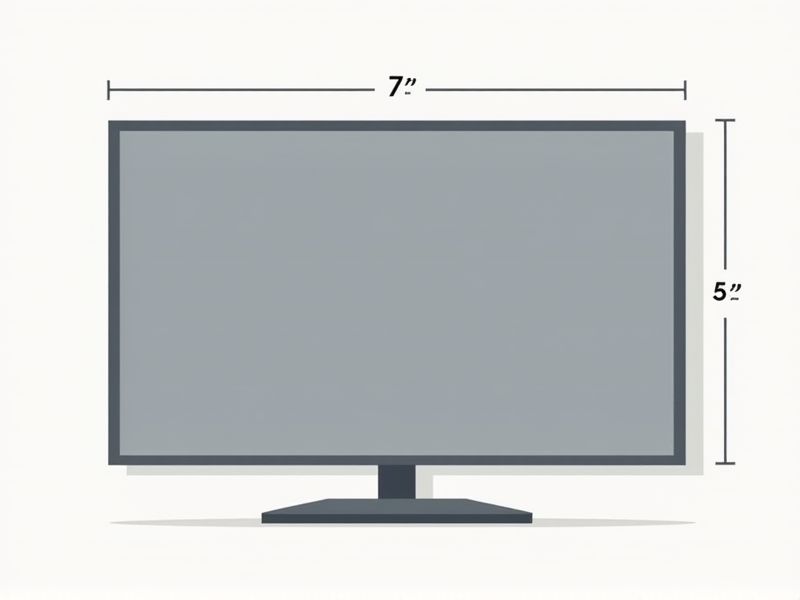
When choosing a TV, understanding the standard dimensions can help you decide what will best fit your space. Most televisions are measured diagonally, with common sizes including 32-inch, 43-inch, 50-inch, 55-inch, 65-inch, and 75-inch screens. For example, a 55-inch TV typically has a width of about 48 inches (122 cm) and a height of roughly 27 inches (69 cm), not including the stand or bezel. Always check the exact specifications from the manufacturer, since screen size doesn't account for the outer frame, and consider your room's layout to ensure a comfortable viewing experience.
Aspect Ratio
Aspect ratio, a key factor in television screen design, refers to the proportional relationship between the width and height of a display. Common aspect ratios include 16:9 for HD and 4K content, providing a widescreen format ideal for immersive viewing experiences. When choosing a TV, consider the screen size in inches, which often ranges from 32 to over 80 inches, ensuring it complements your viewing environment. A proper aspect ratio enhances picture quality, making your favorite movies and shows more visually appealing.
Diagonal Size
The diagonal size of a TV screen, measured in inches, is a critical factor influencing viewer experience and room fit. For example, a 55-inch TV typically measures about 48 inches wide and 27 inches tall, making it ideal for medium-sized rooms. Opting for a larger screen, like a 75-inch model, enhances immersion, especially in spaces over 12 feet in length. When selecting your TV, consider distances; experts recommend sitting 1.5 to 2.5 times the diagonal size away for optimal viewing comfort.
Resolution
Resolution is a critical factor in determining the quality of your TV screen, often measured in pixels. For instance, a Full HD display offers a resolution of 1920x1080 pixels, while a 4K Ultra HD display enhances clarity with 3840x2160 pixels. Higher resolution screens allow for more detail and sharper images, making them ideal for large displays or viewing from close distances. Investing in a higher resolution screen can significantly improve your viewing experience, particularly for high-definition content and immersive gaming.
Screen Type
Television screens are categorized primarily by their screen type, which significantly influences visual quality and viewing experience. LED, OLED, and QLED are the most prevalent screen types, with OLED often praised for its superior contrast ratios and vibrant colors. A high dynamic range (HDR), typically found in modern models, enhances brightness levels and color accuracy, providing a more immersive experience. For optimal viewing, consider the screen resolution, with 4K and 8K options offering higher pixel density for sharper images.
Bezel Size
When selecting a new TV, the bezel size plays a crucial role in your viewing experience. Modern TVs often feature significantly reduced bezel sizes, with many models showcasing bezels as thin as 1.5 mm. This design maximizes the screen-to-body ratio, enhancing immersion while minimizing distractions from the screen's edges. You might also find that a smaller bezel can create a sleeker appearance, making your entertainment space look more streamlined.
Viewing Distance
The optimal viewing distance for a television screen is typically about 1.5 to 2.5 times the diagonal size of the screen. For a 55-inch TV, this translates to approximately 6.9 to 11.5 feet away from the screen for the best visual clarity and comfort. Factors like screen resolution further influence this distance; for instance, 4K TVs allow you to sit closer without noticing pixelation, ideally at around 1 to 1.5 times the screen size. Maintaining this distance can enhance your overall viewing experience, minimizing eye strain while maximizing image quality.
Weight
The standard weight for a 55-inch LED TV typically ranges between 60 to 75 pounds, depending on the model and brand. When considering installation options, it's essential to ensure that your wall mount can support the television's weight; most mounts specify a maximum support load that must be adhered to for safe installation. Manufacturers often provide detailed weight specifications within the product's technical sheets, allowing users to make informed decisions. Proper weight handling will not only guarantee your TV's stability but also extend its longevity by minimizing the risk of damage during setup.
Vesa Mounting Standards
VESA (Video Electronics Standards Association) defines specific mounting standards for televisions to ensure compatibility and stability across various models. The most common VESA mount sizes include 100x100mm, 200x200mm, and 400x400mm, catering to screen sizes ranging from 32 inches to 65 inches and beyond. To ensure optimal viewing experience, use a mount that supports the weight of your TV, typically ranging from 10 to 100 pounds based on screen dimensions. By adhering to VESA standards, you can easily install your TV securely while maintaining a sleek, modern aesthetic in your home entertainment setup.
Hdr Compatibility
HDR (High Dynamic Range) compatibility is a crucial standard for modern televisions, significantly enhancing your viewing experience by delivering a broader spectrum of colors and improved contrast between the brightest whites and the darkest blacks. Leading manufacturers, such as Samsung and LG, often showcase their HDR ratings, which can reach up to HDR10+, Dolby Vision, or HDR10. A screen with HDR capabilities can show up to 1,000 nits of brightness, allowing for stunning visual details that standard dynamic range displays cannot match. Investing in an HDR-compatible TV ensures you experience cinematic quality when streaming content from platforms that support HDR, such as Netflix and Amazon Prime Video.
Refresh Rate
The refresh rate of a television screen is measured in Hertz (Hz) and indicates how many times per second the image is refreshed. A standard refresh rate for most TVs is 60Hz, but higher-end models often feature rates of 120Hz or even 240Hz, enhancing motion clarity during fast-paced scenes. This enhancement is crucial for activities like gaming or watching sports, where fluid motion is essential. When choosing your television, consider a higher refresh rate for smoother visuals and an overall improved viewing experience.
